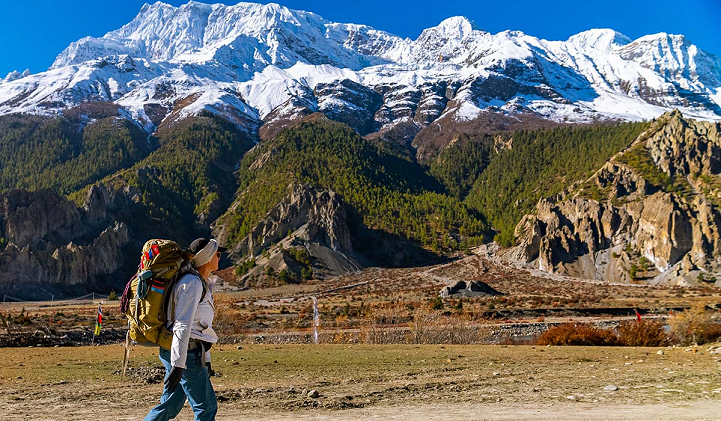How to Support the Local Economy While Trekking the Annapurna Circuit

The Annapurna Circuit trek provides an amazing, diverse visual insight into the Himalayas, but its future as a long-distance trail has everything to do with the financial health of those mountain communities on the Annapurna Circuit in Nepal. This guide details the smartest, most practical tips on making environmentally aware and sustainable economic decisions during your complete Annapurna Circuit Itinerary.
Prefer Annapurna Circuit Trekking agency from locals for better job and employment.
Picking who handles your Annapurna Circuit Tour is the biggest financial decision you will make, and selecting a locally-owned and operated Annapurna Circuit Trek Agency means the vast majority of what you pay remains in Nepal’s economy, feeding into local employment rather than being funneled offshore to some big foreign operators. Not only that, but no matter what your personal experience may be, you need to obey the current rules and hire a licensed local Annapurna Circuit Trek Guide and/or porter; doing so offers jobs directly at a living wage (because we all want more people in tourism, not fewer), supports mountain families, really is the single most efficient way to inject serious money into the rural economy, turning much of the total cost of The Annapurna Circuit Trek into an investment in our communities´ future.
Gain and Fair Trade in the Ethical Teahouse
The entire economic infrastructure of the Annapurna Circuit Trek is predicated on teahouses giving you an affordable place to stay (usually free or very cheap), with the unwritten understanding that you will eat all your meals and hot drink in said establishment, since it’s where the families generate their profit so they can spend money to live and maintain their businesses at high Annapurna Circuit Altitude. To be an ethical consumer, you need to make a steady – dare I say religious? – habit of ordering supper/breakfast/snax from your accom and resist the urge to bring along too much outside snax, which bypasses the fragile local economy: Be Sprint (ordering a big fat plate of) Dal Bhat is about eating with integrity by supporting local agriculture; that’s damn good nutrition plus straight-up honest money spent.
Eating What They Found Around instead of the Import(s)
And though teahouses tend to pander international preferences with cheese-covered pizza and pasta, knowingly selecting local is a strong strategy for supporting regional supply chains and reducing your own environmental impact; imports are paid for at a premium, hauled up the fuel-hungry map of Annapurna Circuit Cost Circle, and do nothing but add on to that Annapurna Circuit Cost figure. Choosing the local, traditional meals like Dal Bhat or Tibetan bread not only decreases dependence on goods from outside the region it also helps support local agricultural economies and preserves cultural culinary practices; this seemingly small dietary decision is one of the most important ways you can spend your money responsibly on a trek in Nepal Annapurna Circuit.
Conscious Spending on Side Services
Aside from the principal expenditures, trekkers have many chances to put local people in business by spending serious money on basic highland services, which work out to be a major headache for teahouse owners and whose outlets are indicated on a trekking map Annapurna circuit. Always pay the small, nominal fees for hot showers (this hot water is heated by costly gas or wood in these villages), battery charges (for costly, inconsistent grid electricity or solar panels) and internet use as not a necessary nuisance but the direct dollar subsidy to infrastructure and energy used paid out by local families who run the businesses on the Annapurna Circuit Trek Map.
Supporting Local Producers and Artisans
Venture beyond the teahouse economy Movement for individuals out of simply living from one tea shop to another is rather limited, but do seek opportunities to buy handicrafts, souvenirs and specialty goods directly from smaller shops and roadside stalls (if you find them) and local artisans themselves — as a carriage trade such establishments are encouraging; some even sell yak cheese!— especially in larger villages like Manang, which serves as major focus on the Annapurna Circuit Short Trek. By buying locally produced items such as handknit woollen goods or local religious icons your money will reach producers and artisans, rather than wholesalers (who often pass just a fraction of the wholesale price on to the actual producer), adding a personal, economic dimension to your Hiking Nepal Annapurna Circuit which is quite directly beneficial and far more meaningful than picking up some garish imported plastic souvenir.
Responsible and Environmental Waste Respect
Whilst not a direct monetary offset, adherence to “Leave No Trace” principles forms an essential part of ethical tourism; poor waste management places a huge (and often impossible) burden on the local authorities and teahouse owners in the Annapurna Conservation Area, for whom cleanup and disposal are financially draining. You will need to take out all of your non-biodegradable trash (no, you cannot leave it behind or throw it in the trail and the village dumps)—plastic bottles and packaging particularly—and fill up from clean local sources as opposed to bought water in disposable plastic bottles if you wish to meet even some of those conservational aims which you have been supporting through that purchase of ACAP permit or TIMS card on your trek tour or trek trps. So that the environment remains intact for our children, our grandchildren, who too shall like us want to pursue their income via guiding, portering treks as an alternative route raththan workingork than being dead poor.
Appropriate and Fair Gratuities
Tips are not compulsory but highly appreciated for local guides and porters. They are a LEGAL requirement in the Annapurna Circuit trekking isn’t only the ultimate method to help ease poor people, yet an affordable way, even though they need to defend you from potential risks at high Annapurna Circuit Altitude, and will also be part of the Annapurna Circuit protection mechanism. Ask your Annapurna Circuit Trekking enterprise or Annapurna Circuit Trek guide what the contemporary and right go price for tipping trekking personnel is, and make sure to hand over the gratuity in coins immediately to your leader guide and porter at the end, acknowledging their worthwhile contribution to a successful trip.
Last Words: Hiking in Annapurna with a Purpose
The place is where it sounds to you; good karma includes a sense of responsibility and intention from your part – turning the expense you are incurring from mere cost into an essential, economic fillip directly to the people of the mountain communities of Annapurna Circuit, Nepal. With the decisions you make—hiring local through an authorized Annapurna Circuit Trek Agency and supporting teahouse meals to buying locally every opportunity that presents itself and being eco-aware—you guarantee that your adventure in Nepal trek is not just a breathtaking experience for you, but one which is truly sustainable and financially beneficial to the indomitable communities who inhabit this glorious land making your trip a winning journey in variety of ways, securing the long term value of the Annapurna Circuit Trek Nepal.

